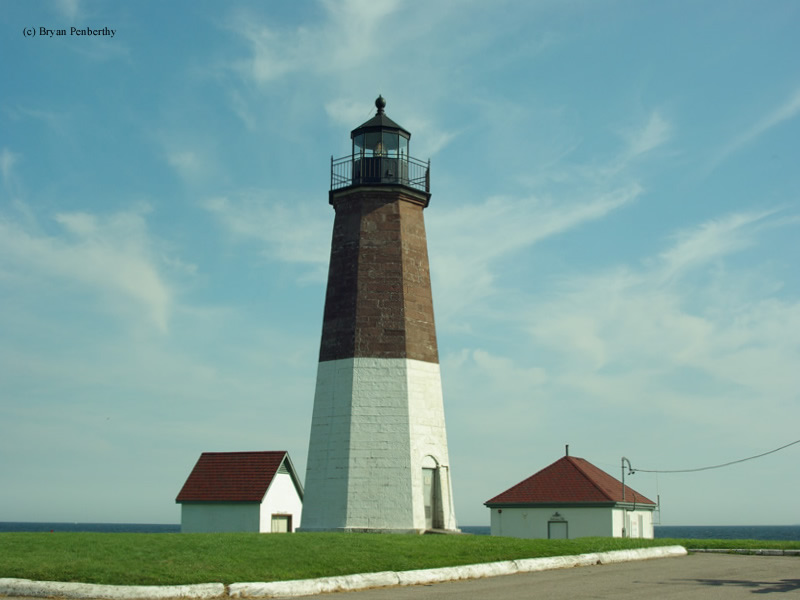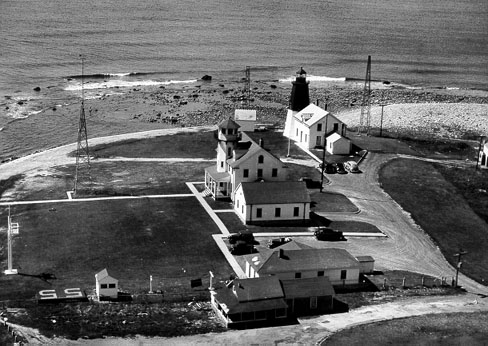Point Judith Lighthouse
Point Judith, Rhode Island - 1857 (1810**)

History of the Point Judith Lighthouse
Posted/Updated by Bryan Penberthy on 2013-01-01.
Point Judith, sticking out from the Rhode Island coast over a mile, is one of the most exposed and dangerous points of land on the East Coast. Because of its location near the entrance of Narragansett Bay many vessels encountered it while traveling between New York and New England. The area is frequently enshrouded in heavy fog and rough seas coupled with heavy maritime traffic led to many mishaps on the nearby Squid Ledge. The location is sometimes referred to as the "Cape Hatteras of New England" in reference to Cape Hatteras being known as the "Graveyard of the Atlantic."
Congress recognized the need for a light at that location, and passed an act on January 19, 1808 that stated, "That the Secretary of the Treasury shall be authorized to cause a good and sufficient light-house to be erected on Point Judith, in the State of Rhode Island, and to appoint the keeper of said light-house, under the Direction of the President of the United States, and otherwise to provide for such light-house at the expense of the United States."
The funding for the project came a month later on February 10, 1808 with an appropriation of $5,000. The land was purchased on May 25, 1809 from Hazard Knowles for $300. It would still be another year before the first Point Judith Lighthouse would be built by contractor Daniel S. Way. It was built in 1810, making it the third lighthouse in Rhode Island behind Beavertail Lighthousein 1749, and Watch Hill Lighthouse in 1808.
The lighthouse, constructed of wood, was octagonal in shape and stood atop of two-foot-high stone pedestal. The lamps were suspended by chains and utilized an eclipser to give the appearance of a flash. The lighthouse would be in service for five years before being destroyed during a hurricane in 1815.
The replacement lighthouse built in 1816 was made possible by an appropriation of Congress on April 27, 1816 in the amount of $7,500. The thirty-five foot tall octagonal tower was constructed of rough stone, faced with freestone, and then coated over with cement.
A report of 1838 by Lieutenant George M. Bache lists the lighting apparatus as two clusters of lamps arranged on copper tables outfitted with parabolic reflectors. The tables were then rotated by a 228-pound weight attached to a rope that was wound around a horizontal barrel. The barrel was then connected to a spindle by means of a wheel and pinion, and the tables are placed on the spindle to provide the revolutions.
The report listed several deficiencies in the apparatus. The silver on the reflectors was well worn exposing copper underneath; the lamps were not firmly fixed upon the tables, the revolutions of the lighting apparatus were reported as consistently slow, but without a watch, the keeper had no way of knowing.
Like many lighthouses during this time period, the tower was reported to have poor ventilation. During the colder months, the dampness would condense on the glass of the lantern and freeze. Many times, the keeper would have to wait for the ice to thin before trying to remove it for fear of breaking the glass.
When the keeper's dwelling was first constructed, it had a single bedroom which was in the attic. The structure had poor heating, that many winter nights, the family slept in the kitchen to keep warm. Over the years, it appears that the structure was enlarged as the report of 1838 listed the structure as having seven rooms and noted that it required painting and a new kitchen floor.
By 1855, the keeper's dwelling and the lighthouse were in poor condition, and it was recommended by the Lighthouse Board that both structures be replaced. It was recommended that the new dwelling be placed as close to the tower as possible in anticipation that the tower be connected to the dwelling in the future.
A fifty-one foot high octagonal brownstone tower was constructed in 1857. As requested, the new keeper's dwelling was constructed close to the tower. In lieu of the old parabolic reflectors and lamps, a new fourth-order Fresnel lens was installed in the lantern illuminated by single brass oil lamp.
In 1867, a fog signal was established at the site. A Wilcox caloric engine powered a Daboll trumpet to warn mariners of the dangers. However, by 1871, it was deemed ineffective as mariners complained that it could not be heard above the roar of the surf, and others complained that it was too similar to the fog signal at nearby Beavertail Lighthouse.
Petitions were received in 1871 requesting the changes be made to address the deficiencies. The Lighthouse Board agreed, and put forth the recommendation with an estimated cost of $5,000. By 1872, construction of the fog signal structure was in progress, and it was reported that the new steam whistle would be in operation by early September of that year. The following year, the fog signal equipment was reported as being in use for 548 hours.
With the addition of fog signal equipment to the station, it became necessary to hire assistant keepers to help with the expanded duties. In 1874, $8,000 was appropriated for the building of additional quarters to house the assistant keepers.
Between 1875 and 1886, various repairs and upgrades were made to the fog signal equipment. The older upright boilers were replaced with the more efficient locomotive style boilers. The gallery between the dwelling and the tower was covered, and an oil room was constructed in the new space. The old oil room was made into a kitchen for the assistant keeper.
 Point Judith with attached dwelling (Courtest Coast Guard)
Point Judith with attached dwelling (Courtest Coast Guard)
It appears that 1899 was when the Point Judith Lighthouse received its distinctive color scheme. The Annual Report of the Lighthouse Board states that the color of the upper half of the tower was changed from white to brown giving the tower its unique day mark.
By 1902, the steam signal was upgraded to use compressed air. The steam equipment was replaced with twin 16-horsepower engines and two automatic first class sirens with Crosby automating devices. This equipment went into effect on October 10, 1902.
Records indicate that vessel traffic passing by the Point Judith Lighthouse in 1907 was 22,680, with twice that number passing at night, which is more than four times the number of vessels entering the New York Harbor. As shipping traffic in the area remained heavy, the illuminating apparatus was upgraded to the more efficient incandescent oil vapor and a new fourth-order Fresnel lens was installed on January 2, 1907.
Several new buildings were constructed over the years. In 1917, a concrete oil house with asbestos shingle roof was built to store kerosene, and in 1923, a new fog signal building was constructed. In 1931, the first radio beacon installed at a Rhode Island lighthouse was established at Point Judith. By 1937, the Coast Guard was constructing several administrative buildings on the grounds. The lighthouse was automated in 1954 at which point the attached brick keeper's quarters were torn down.
By 2000, the lighthouse was in need of repairs. The lantern was removed and sent for rehabilitation. When it was reinstalled on the tower, it was outfitted with all new windows. Many of the brownstone blocks had weathered badly and were in need of replacement. The new stones were dyed to match the old ones. And finally, the cracks were repaired with a special mortar.
Reference:
- Northeast Lights - Lighthouses and Lightships, Robert G. Bachand, 1989.
- America's Atlantic Coast Lighthouses (6th edition), Jeremy D'Entremont, 2005.
- Annual Report of the Light House Board, U.S. Lighthouse Service, Various years.
- U.S. Coast Guard website.
- New England Lighthouses: A Virtual Guide website.
Directions: The lighthouse sits at the end of Point Judith Road (Highway 108). From Highway 1, follow Highway 108 south to the end.
The lighthouse is an active Coast Guard base. While I was there, I was taking pictures from the parking area next door. A member of the Coast Guard told me that it was fine to come in and walk the grounds to take pictures. He said they have a gate up so that people don't park their cars on the base grounds as they only have about 5 or 6 parking spots.
Access: The lighthouse sits on the grounds of an active Coast Guard base. Grounds open. Tower closed.
View more Point Judith Lighthouse picturesTower Height: 51.00'
Focal Plane: 65'
Active Aid to Navigation: Yes
*Latitude: 41.36100 N
*Longitude: -71.48100 W
See this lighthouse on Google Maps.
